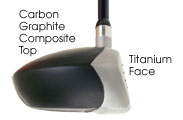 The golf club driver is the club used for maximum distance. Typically it is used only from the tee box but occasionally a good player will hit it “off the deck” from the fairway. The driver is the longest club in the bag which makes it about the hardest club to hit straight. The new drivers with their large heads and sweetspots do compensate for that a wee bit.
The golf club driver is the club used for maximum distance. Typically it is used only from the tee box but occasionally a good player will hit it “off the deck” from the fairway. The driver is the longest club in the bag which makes it about the hardest club to hit straight. The new drivers with their large heads and sweetspots do compensate for that a wee bit.
In 1981 TaylorMade developed the first metal “woods”. Since then, drivers and fairway metal woods have been made from the same metals using pretty much the same processes.
Metal woods have their advantages over “wood” woods. When drivers were made out of wood (persimmon to be more precise) there wasn’t a whole lot that could be done to make them more forgiving. When TaylorMade came out with it’s Pittsburg Persimmon line of metal “woods” that began to change.
Originally the metal woods were not very different looking than their wooden versions. The only advantage was a more stable face that could be manufactured very consistently. Their stability created a greater Moment of Inertia (MOI) so generally shots flew straighter on mishits.
 In the late 80s driver manufacturers began to experiment with different kinds of metals, and variations in clubhead shape. In 1991 Callaway developed the first oversized driver, the Big Bertha and bigger was in. In its day the big lady was quite a sensation and in 1992 the club claimed winners on all 4 professional tours. Clearly Callaway and their Big Bertha was the initiator of the “bigger is better” trend in drivers-even at only 190 cc.
In the late 80s driver manufacturers began to experiment with different kinds of metals, and variations in clubhead shape. In 1991 Callaway developed the first oversized driver, the Big Bertha and bigger was in. In its day the big lady was quite a sensation and in 1992 the club claimed winners on all 4 professional tours. Clearly Callaway and their Big Bertha was the initiator of the “bigger is better” trend in drivers-even at only 190 cc.
Titanium Comes of Age
Around the mid 90s titanium was introduced. Titaniun is lighter and stronger and more elastic than other metals but it costs quite a bit more. Titanium makes it possible to create the large driver heads we see these days. Once titanium was introduced, drivers would never be the same again.
Does titanium really give you more distance?
Titanium, as mentioned, allows you to create very large clubheads because it is lighter. Lighter means bigger while maintaining the standard weight required for most drivers. Did you know that all drivers, across all brands have about the same weight? Did you know that the driver head is the lightest of all the clubheads in your bag? The sand wedge is the heaviest.
Larger heads mean that the optimum hitting area can be larger. That implies that you should be able to hit the ball squarely more often. Also, the lightness of the clubhead combined with the new lightweight graphite shafts means you can swing the clubhead a little faster. How much faster is debatable. The net result should be longer and straighter drives. Life is good.
Spring Like Effect
There is also an argument that the spring like effect of the titanium club face increases ball speed as it comes off the face. What is the spring like effect? We mentioned that titanium was a bit more elastic than regular steel. It’s also stronger so the face can be made a little thinner. That means the face can act a little more like a trampoline and spring the ball off the clubface.
Does it really help? The testing by the USGA concluded that for people with very high club head speeds (nobody that I know) it might make a difference of seven or eight yards. For the average golfer the difference is minor. At any rate the USGA has come out with rules limiting the amount of the “spring like effect” or more accuarately, Coefficient of Restitution (COR). That means in the future you won’t be seeing too many major changes in drivers because they may have reached their allowable limits.
Manufacturing techniques

Today’s drivers and wood heads are actually made from multiple pieces that are welded together. Sometimes as many as four or five pieces. The driver face is usually titanium with the other parts being various types of carbon fiber. Carbon fiber is even lighter than titanium so that allows designers to move the weight around in more optimum ways. Typically you’ll find carbon fiber tops. That allows the weight to be distributed lower and farther back from the face.
Most fairway woods are still usually made from steel because they would become too expensive if they used titanium as well. There’s only so many $300 clubs that we will put in our bags. But there are titanium fairway woods out there if you want them.
The latest technology has yet to be fully applied to woods, so in the near future you may be seeing some design advances in fairway woods. There’s plenty of room for improvement using what has been learned from drivers.
Launch Angle and Driver Loft
With the development of the new balls with lower spin rates something new has been discovered with drivers. During the 80s and 90s people assumed that the lower the loft the farther the ball would go. What the golf scientists have found is that in order to maximize distance, the clubhead should launch the ball at higher angles than in the past. This means that many of us are probably playing drivers with too little loft.
Driver loft should match your swing speed. The slower your swing speed the more loft you should have. If your average swing speed is between 80 and 90 (the average for most male golfers) you should be using a driver with about 13 degrees of loft. Combined with the new balls this means your launch angle and spin rate will be optimized. So the good news is: getting fitted with a large headed titanium driver with the correct loft means you have a real chance of adding some distance to your drives.
| Swing Speed | Driver Loft | Launch Angle | Carry Distance |
| 60 | 11 15 19 |
12.1 15.2 18.1 |
106 117 122 |
| 70 | 11 15 19 |
12.1 15.2 18.1 |
145 154 156 |
| 80 | 9 11 13 |
10.5 12.1 13.7 |
174 181 185 |
| 90 | 9 11 13 |
10.5 12.1 13.7 |
206 211 213 |
| 100 | 8 9 10 |
9.6 10.5 12.1 |
231 234 236 |
| 110 | 7 8 9 |
8.8 9.6 10.5 |
254 256 257 |
Weight ports: do they do what they say?
The most popular driver on the PGA tour is the TaylorMade r7. It’s unique feature is the 2 or 4 weight ports (depending on model) that allow you to change the center of gravity by moving and adding weight around the clubhead. Theoretically you can produce different types of ball flight depending on how you configure the weights. Reports say that this technology works and you might be able to compensate for slices, draws and low shots by moving the weights to the appropriate location. However, you do need to make relatively drastic changes before you’ll see much of a difference. Some of the manufacturers that make weight port drivers include TaylorMade, Adams, Pinemeadow, Golfworks, GigaGolf, etc. Click on the TaylorMade R7 to the right to learn more.
How About Face Angle
You can buy clubs with the face adjusted to be closed or open. A closed face will help compensate for a slice and an open face will compensate for a hook. Does it work. Yes it does. Is it difficult to look down at a face that is not pointing at the target. Yes it is. That’s why I’ve never tried it. I’d rather work on improving my swing. It is an option that you can consider. How do I know it works. Tom Wishon, one of the great golf club designers, and many others say it does. That’s good enough for me.
What Should You Do?
The bottom line is if your driver is more than 3 or 4 years old it’s probably a good time to upgrade. If you think it’s a lot of money to spend you are right. But it may be worth it. The new large headed drivers hit the ball a little longer and a whole lot straighter. The biggest change may be in confidence. It’s hard to feel like you can’t hit that sweet spot with that gigantic head.
If you don’t want to spring for one of the big brand names with the big brand price consider a used club or at least a tryout of a clone version of the club. Most of the good clone suppliers offer a 30 day tryout period. I doubt you’ll be sending it back though. When your drives start going longer and straighter you’ll be hangin on. Check out if you want to try a clone driver.
I find that I can hit my TaylorMade 420cc driver just as straight as my 3 wood. If I’m playing a hole where I can’t use all of the distance, I just choke up and it goes even straighter. It really brings a new level of confidence to that tee box.
About the Length
Like irons, drivers have been getting progressively longer. The larger sweet spots help compensate for that a little, but remember our rule about clubs…the longer it is and the less loft, the harder it is to hit straight. A drive in the fairway is always better than a longer drive into the woods.
The leading brand name drivers these days are the TaylorMade r7, The Callaway Big Bertha Fusion and X460, and the Nike Sasquatch. Tiger Woods plays the Sasquatch.
Are these clubs really superior to the many others available? Golf Digest and it’s Hot List testing process think that they are. All rated high in that test with the Sasquatch gaining an Editors Choice award for 2006.
The question is…are these right for you. In my opinion, there are many drivers that will work well for most golfers. Especially if they are properly fit. Will the top-of-the-line, top dollar driver give the average player a significant performance boost. The answer is probably not.
If there really was one driver that was better than the rest most of the tour pros would be playing that driver. They don’t. They play the driver from the company that pays them their endorsement money. Do you think Tiger would play a club that wasn’t absolutely perfect for him? No way. But he does take a good club and makes sure it’s absolutely perfectly fit for him and his swing.
That’s the lesson. Get good quality and make sure it’s right for you. That club may be an r7, or a Sumo, or Big Bertha, or maybe a clone version of one of those, but make sure the shaft and the loft are a good match for your swing. How do you do that? We reveal all in our club fitting section.

